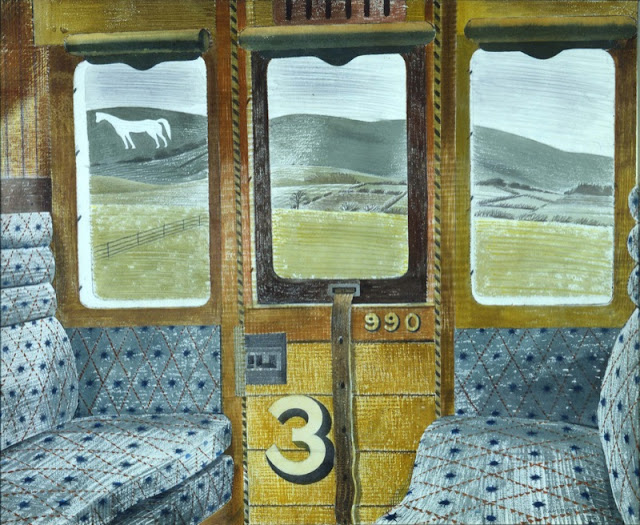From Eric Ravilious, Edward Bawden and Paul Nash to Elisabeth Frink,
David Hockney and Lucian Freud some of the biggest names in British art are
coming together in a vibrant, wide-ranging exhibition at The Higgins Bedford that
explores the history of British art of the 20th and 21st
centuries.
Changing
Times: A Century of Modern British Art brings together more than 80 works from the
Ingram Collection of Modern British and Contemporary Art and The Higgins’ own
collection, with paintings, works on paper and sculpture from some of the
biggest names in British art. From The Higgins also come a dozen works on paper
by major European artists.
Changing Times: A Century of Modern British Art will be
the first large-scale exhibition since the reopening of The Higgins, and is supported by The
Friends of The Higgins Bedford.
Among the
highlights are several powerful monumental sculptures, including Riace
Figure (1986) and Walking Madonna (1981) by Elisabeth Frink, and
Ralph Brown’s Meat Porters (1959). There are lithographs by Eric
Ravilious from his High Street series and a pair of his watercolours, Observation
Post (1939) and Rye Harbour (1938). Lucien Freud’s stunning 1945
drawing Botanical Gardens hangs alongside works John Craxton’s exquisite
Yellow Estuary Landscape (1943).
A Cezanne
lithograph, Large Bathers (1896), introduces a section devoted to
figures in the landscape, which includes Edward Burra’s Hop Pickers Who’ve
Lost Their Mothers (1924), John Minton’s Hop Pickers (1945), the
early Paul Nash watercolour Fruit Pickers (1916) and The Bathing Pool
(1923) by Ethel Walker, a highly regarded interwar artist who deserves to be
better known. The same is true of Frances Hodgkins, whose work is also featured
in Changing Times.
Another
section explores the artist’s self-portrait, with David Hockney’s tongue-in-cheek
etching Artist and Model alongside works by Kathe Kollwitz, William
Roberts, John Bratby and John Bellany. Elsewhere the emphasis is on experiment
and play, with Mark Gertler’s eerie still life The Doll (1914) and a
lithograph from Marc Chagall’s Arabian Nights (1948) suite. Hockney
prints depicting water can be seen alongside Howard Hodgkin’s colourful etching
of Hockney’s swimming pool. Bold colour abounds in works by Sybil Andrews,
Sonia Delaunay and Victor Pasmore, to name a few.
Changing
Times is curated by
James Russell, whose previous exhibitions include Ravilious (2015) and Edward
Bawden (2018), both at Dulwich Picture Gallery.
James says,
“What a pleasure it has been to explore these two sensational collections,
teasing out themes and points of connection. Visitors will see works by dozens
of artists, from household names to the brilliant-but neglected. They will be
able to trace patterns of development and influence through the last hundred
years of British art, or simply revel in an array of artworks that are by turns
colourful, mysterious, thoughtful and fun.”
The exhibition is accompanied by a major new book - Revisiting
Modern British Art, published in
association with The Ingram Collection and edited by Jo Baring (Director, The
Ingram Collection). In this wide-ranging and thought-provoking
publication, published in October by Lund Humphries, experts in their field,
including Changing Times curator James Russell, address specific aspects
of British art of the 20th-century. Complemented by a range of
striking images, this publication succeeds in showing the strength of the
British artistic tradition while also encouraging the reader to rethink and
explore the existing narrative.
Changing Times is at The Higgins Bedford, from 15 Oct 2022 until 16 April 2023 - follow link for info!










